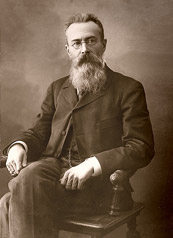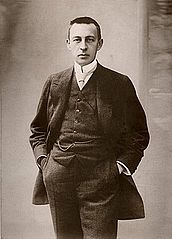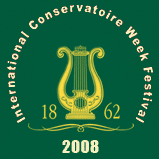|
NIKOLAI RIMSKY-KORSAKOV
 2008
marks the centenary of the death
of Nikolai Rimsky-Korsakov —
and St. Petersburg Conservatoire bears his name.
Rimsky-Korsakov, a member of “The Five” (or
“Mighty Handful”), played an important role in the
development of Russian music. His compositions
include operas, such as Snowmaiden, Sadko, The
Tsar’s Bride, The Golden Cockerel; symphonic
suits: Scheherazade, Antar, various choral works
and chamber vocal cycles. Rimsky-Korsakov
always remained a truly Russian composer and
managed to bring up his students — Anatoly
Lyadov, Alexander Glazunov, Igor Stravinsky and
many others — in the spirit of national musical tradition, encouraging
them to preserve it and make it a part of the European musical legacy.
His professional duty and devotion to his friends’ memory made Rimsky-Korsakov complete the unfinished works of Modest Mussorgsky and
Alexander Borodin — these works were made public through Rimsky-Korsakov’s mammoth efforts: he had edited the scores. In his decades
as a professor in the St. Petersburg Conservatoire the composer taught
a great number of talented musicians.
2008
marks the centenary of the death
of Nikolai Rimsky-Korsakov —
and St. Petersburg Conservatoire bears his name.
Rimsky-Korsakov, a member of “The Five” (or
“Mighty Handful”), played an important role in the
development of Russian music. His compositions
include operas, such as Snowmaiden, Sadko, The
Tsar’s Bride, The Golden Cockerel; symphonic
suits: Scheherazade, Antar, various choral works
and chamber vocal cycles. Rimsky-Korsakov
always remained a truly Russian composer and
managed to bring up his students — Anatoly
Lyadov, Alexander Glazunov, Igor Stravinsky and
many others — in the spirit of national musical tradition, encouraging
them to preserve it and make it a part of the European musical legacy.
His professional duty and devotion to his friends’ memory made Rimsky-Korsakov complete the unfinished works of Modest Mussorgsky and
Alexander Borodin — these works were made public through Rimsky-Korsakov’s mammoth efforts: he had edited the scores. In his decades
as a professor in the St. Petersburg Conservatoire the composer taught
a great number of talented musicians.
After the Russian concerts at the World Fair in Paris (1889)
Nikolai Rimsky-Korsakov acclaimed international fame. His opera
The Golden Cockerel as well as his adaptation of Mussorgsky’s
Boris Godunov were staged at Dyaguilev’s Saisons Russes.
The composer’s heritage has become the subject of research
for many scholars around the world: M. Calvocoressi (France),
R. Newmarch (UK), R. Taruskin (USA). Rimsky-Korsakov’s works
are widely staged and performed in Russia and all over the
world.
RACHMANINOFF AND ST. PETERSBURG
 St. Petersburg was Rachmaninoff’s home in his
childhood, the scene for premieres of many of
his works and for his performances as pianist and
conductor, the field for his charity and social engagement. The city was home for his family and friends
who Rachmaninoff stayed with during his numerous
visits. Even the composer’ appearance, as he was
slightly rigid and reserved with strangers as described
by his contemporaries, was matched by the city’s official classicism and rigidity of silhouettes. On the other
hand, their relations were far from perfect.
St. Petersburg was Rachmaninoff’s home in his
childhood, the scene for premieres of many of
his works and for his performances as pianist and
conductor, the field for his charity and social engagement. The city was home for his family and friends
who Rachmaninoff stayed with during his numerous
visits. Even the composer’ appearance, as he was
slightly rigid and reserved with strangers as described
by his contemporaries, was matched by the city’s official classicism and rigidity of silhouettes. On the other
hand, their relations were far from perfect.
The first encounter with St. Petersburg took place
in 1882 when Sergei was nine years old. Three years of studies at the conservatoire did not turn out as it had been expected: his laziness and constant academic failures resulted inevitably in flunk (a few years later Rachmaninoff will graduate from the
Moscow Conservatoire and be awarded with the Great Gold Medal). The second Rachmaninoff’s “educational contact” with the St.
Petersburg Conservatoire will take place many years later: having
already become a famous composer he will write an accompaniment to a given theme for his niece, Zoya Pribytkova, conservatoire
student, and Professor Vitol, unaware of who is the true author, will
give it a C.
One of the greatest shocks and the event that most deeply
wounded Rachmaninoff was the failure of his Symphony No. 1 premiered in St. Petersburg on March 15, 1897. Negative feedback
from the critics, public and even colleagues, including Nikolai Rimsky-Korsakov, produced a severe depression that lasted three years,
during which he wrote virtually no music.
Maybe it was the failure of the First Symphony that inspired Rachmaninoff to premiere his Symphony No. 2 (1908) in St. Petersburg.
By that time he gained a wide acclaim as pianist, composer and conductor and the concert-hall of the Nobility Assembly (now the Grand
Philharmonic Hall) as well as Mariinsky and Mikhailovsky theatres
were always full during his performances. His Piano Concerto No.
2 and Spring Cantata were highly praised by Rimsky-Korsakov and
awarded with the Glinka Prize. Magnificent premiere of the Second
Symphony seemed to be a revenge for the previous failure.
Just a few days later the Small Hall of the Conservatoire hosted
another manifestation of revenge: the previously underestimated
and coldly greeted by the Petersburg audience Trio elegiaque “To
the Memory of the Great Artist” received a standing ovation. The
Conservatoire scene proved to be “100 percent lucky” for Rachmaninoff, later many of his works were successfully premiered or
performed here like Six Songs Op. 38, Etudes-Tableaux Op. 39 or
The Bells Op. 35.
St. Petersburg was the center of the Russian Revolution of 1917
that put an end to Rachmaninoff’s way of life and essentially his
world. And it was in St. Petersburg that Rachmaninoff bid his last
farewell to Russia: here he received a permission to leave the country with his family and the Finland railway station was the last picture that he saw of his homeland before leaving it forever.
Homesickness and melancholia, thoughts about Russia and its
fate, realization of impossibility of return were the permanent companions of Rachmaninoff’s later years. His last will to be buried at
home was never fulfilled.
Nowadays Sergei Rachmaninoff returns to Russia and St. Petersburg, to the St. Petersburg Conservatoire with his music. The
memory of the great Russian composer chimes like bells in the
hearts of those who value his immortal name.
|


